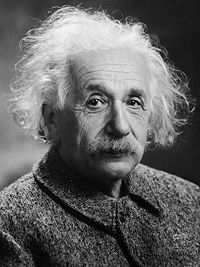Rest Mass Energy
Provide a brief summary of the page here
Rest Mass Energy
Work In Progress - Shiv Tailor HAI SHIV <3 -Alice Rest mass energy is the energy an object has when is not moving nor is it in a potential field. The famous equation
[math]\displaystyle{ E=mc^2 }[/math]
demonstrates the mass energy equivalence. What this equation means is that the Internal Energy (E) in Joules is equal to the mass (m) in kilograms times the speed of light (c) in meters per second squared.
This incredible relationship was shown by Albert Einstein in 1905.

A Mathematical Model
This is a very simple equation but it can be rewritten in many ways.
[math]\displaystyle{ E/(c^2)=m }[/math]
This is especially important because it says that all the energy, regardless of form, can be equated to mass
A Computational Model
The best way to visualize this mass-energy equivalence to think about a pan on a stove. As the pan heats up one would see that the pan gets hotter, and one could infer that the internal energy of the pan goes up. This change in energy can be equated to mass. This is shown in the examples.
Examples
Be sure to show all steps in your solution and include diagrams whenever possible
Simple
What is the rest mass energy of an object that weighs 7 kg and is going 40 mi/h?
Solution: Since it asks for rest mass energy, we ignore the movement.
E = mc^2
E = (7kg)*(3e8 m/s)^2
E = 2.1e9 J
Middling
What is the mass of an object that has a rest mass energy of 1e16 J and is traveling through a medium where the speed of light is 2e8 m/s?
Solution: The rest mass energy always uses the speed of light in a vacuum (c) which is ~3e8 m/s.
E = mc^2
m = E/c^2
m = 0.11 kg
Difficult
History
Put this idea in historical context. Give the reader the Who, What, When, Where, and Why.
See also
Are there related topics or categories in this wiki resource for the curious reader to explore? How does this topic fit into that context?
Further reading
Books, Articles or other print media on this topic
External links
Internet resources on this topic
References
This section contains the the references you used while writing this page